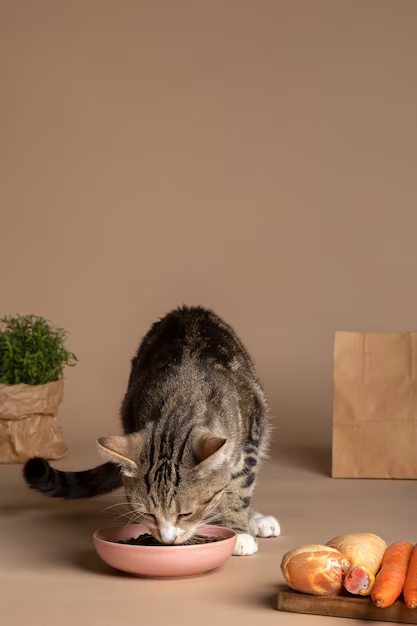How to Create a Balanced Diet for Your Cat: A Complete Guide for Pet Parents

There’s a reason your cat gives you that look when it’s mealtime—their health, energy, and mood are all tied to what lands in their bowl.
Just like us, cats thrive on a balanced, nutritious diet. But unlike us, they’re obligate carnivores with very specific dietary needs. As a loving pet parent, you want to feed your feline friend right—but what exactly does a balanced cat diet look like? How much protein? What about treats? And is milk really okay for cats?
You’ve come to the right place. At High Furries, we help pet parents build the purrfect nutritional plans for their pets. From consultations to curated meal plans, we ensure your furry companion gets the food fuel they deserve.
Let’s dive whiskers-first into the science and soul of feeding your cat well.
Why a Balanced Diet Is Crucial for Your Cat’s Health
A balanced diet isn’t just about full bellies—it’s the foundation of your cat’s entire life.
Cats need the right mix of proteins, fats, vitamins, minerals, and hydration to support:
- Muscle growth and repair
- Immune function
- Skin and coat health
- Kidney and urinary function
- Healthy digestion
- Cognitive function
Too much or too little of any nutrient can lead to serious health issues, including obesity, diabetes, heart disease, or urinary problems.
High Furries Tip: Many health concerns in cats stem from dietary imbalances. Regular nutrition checks and meal planning with experts—like the ones at High Furries—can prevent long-term complications.
What Does a Balanced Cat Diet Include?
Cats are obligate carnivores, which means their bodies require nutrients found only in animal tissue. Unlike dogs (or humans), they can’t survive on plant-based diets.
Here’s a breakdown of what a complete, balanced cat diet must include:
1. Protein – The Main Event
Cats need a high-protein diet for muscle maintenance, organ function, and energy. Look for named animal proteins like:
- Chicken
- Turkey
- Fish (salmon, sardines)
- Lamb
- Rabbit
Key Nutrients in Animal Protein:
- Taurine: Essential for heart and eye health
- Arginine: Important for detoxification
- Methionine & Cysteine: Promote healthy skin and fur
High Furries Tip: Always check the label. If the first ingredient isn’t a named animal protein, skip it!
2. Healthy Fats – For Shine and Energy
Fats are essential for:
- Healthy skin and coat
- Absorption of vitamins A, D, E, and K
- Brain and nervous system development
Look for:
- Omega-3s from fish oil
- Omega-6s from chicken fat or flaxseed
Bonus: Omega-3s also reduce inflammation and support joint health, especially in older cats.
3. Carbohydrates – Not Too Much, Not Too Little
Cats have a limited ability to digest carbs, but they can benefit from small amounts of digestible carbohydrates for fiber and energy.
Examples:
- Pumpkin (great for digestion)
- Sweet potato
- Rice or oats (in moderation)
Avoid: Corn, soy, wheat fillers.
4. Vitamins & Minerals – The Silent Superheroes
Micronutrients play a huge role in your cat’s overall health. Key ones include:
- Calcium & Phosphorus – Bone strength
- Zinc – Skin and coat
- Vitamin A – Vision and immunity
- B vitamins – Energy production
These should come from meat sources or balanced supplements—not random kitchen scraps.
5. Water – The Unsung Hero
Cats are notorious for not drinking enough water, which can lead to kidney and urinary problems.
Ways to boost hydration:
- Feed wet/canned food regularly
- Use cat fountains (they love running water!)
- Add water/bone broth to kibble
High Furries Suggestion: A combination of dry and wet food can help balance hydration and nutrition. Our experts can create the perfect mix based on your cat’s age and health.
Wet Food vs. Dry Food: Which Is Better?
Both have their place—but understanding the pros and cons helps you choose wisely.
Wet Food:
- High moisture content
- Lower in carbohydrates
- Easier to digest
- Great for picky eaters and seniors
Dry Food:
- Convenient and budget-friendly
- Can help with dental health
- Long shelf-life
Best Practice? Use both! A rotational diet or mixed feeding plan keeps your cat interested and nutritionally balanced.
Not sure what to pick? Book a consultation with High Furries, and let our nutritionists create a custom meal chart for your feline.
Life Stage Nutrition: What Your Cat Needs Based on Age
Just like humans, a kitten’s needs differ from a senior cat’s. Here’s how:
Kittens (0–12 months):
- Need 2–3x more calories per kg of body weight than adults
- High-protein, high-fat diet
- Frequent feeding (3–4 times/day)
Adults (1–7 years):
- Balanced, maintenance diet
- Monitor weight and activity levels
- 2 meals/day or timed feeding
Seniors (7+ years):
- Lower calorie intake but high-quality protein
- Digestive support (fiber, probiotics)
- Joint support (glucosamine, omega-3s)
High Furries provides senior cat nutrition assessments and kitten weaning programs to ensure every stage is covered with care.
Human Foods & Ingredients to Avoid
You might be tempted to share your snack—but many human foods can be toxic to cats.
Dangerous Foods:
- Chocolate
- Onions & garlic
- Grapes & raisins
- Alcohol
- Caffeine
- Raw dough or eggs
- Bones (can splinter)
Avoid artificial colors, sweeteners (like xylitol), and preservatives in commercial food.
High Furries Reminder: Even healthy-sounding foods can be harmful in large amounts. Always check with a vet before introducing new items.
Sample Balanced Daily Diet for an Adult Cat (4–5 kg)
This is just a guideline. Portion sizes and ingredients should be adjusted to your cat’s unique needs.
Breakfast:
- ½ can of wet food (tuna or chicken)
- 1 tsp fish oil (omega-3s)
Lunch (Optional for active cats):
- Small cooked chicken piece (no bones or seasoning)
- A few steamed carrots or pumpkin cubes
Dinner:
- ¼ cup dry kibble (grain-free)
- 2 tbsp bone broth mixed in
Treats:
- Freeze-dried liver or salmon (limit to 10% of daily intake)
Want a personalized chart based on breed, weight, and health? High Furries can design a meal plan tailored just for your kitty.
When to Consult a Vet or Pet Nutritionist
Changes in appetite, weight, stool quality, or coat condition are all red flags. Nutrition might be the hidden culprit.
Contact a High Furries expert if:
- Your cat gains/loses weight unexpectedly
- You’re transitioning from kitten to adult or adult to senior food
- Your cat has allergies, sensitivities, or special needs (e.g. diabetes, kidney issues)
- You’re switching from commercial to homemade/raw diets
Should You Try Homemade or Raw Diets?
Some pet parents explore homemade or raw food diets for their cats. While these can be beneficial if done correctly, they require careful planning to avoid nutritional deficiencies.
Pros:
- Full ingredient control
- No additives or preservatives
- Can be tailored for sensitivities
Risks:
- Unbalanced meals
- Bacterial contamination
- Lack of essential nutrients (like taurine)
Thinking of switching? High Furries offers step-by-step raw/homemade diet planning under the guidance of certified pet nutritionists.
High Furries: Your Partner in Cat Nutrition & Wellness
At High Furries, we know that a well-fed cat is a happy, healthy cat. That’s why we go beyond food to offer a holistic approach to feline care.
What We Offer:
- 1:1 Nutritional Consultations
- Custom Meal Plans by Age/Breed
- Pet Food Recommendations
- Raw/Homemade Diet Support
- Pet Wellness Kits & Supplements
- Allergy & Digestive Issue Assistance
Our goal? To empower every pet parent to confidently feed their cat with love, balance, and knowledge.
Ready to Feed Your Cat the Right Way?
It’s never too late to start nourishing your cat the right way. A balanced diet not only adds years to their life—it adds life to their years.
Take the first step with High Furries:
Book a Cat Nutrition Consultation today
